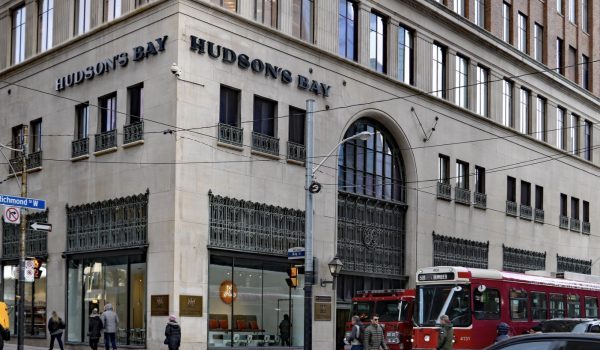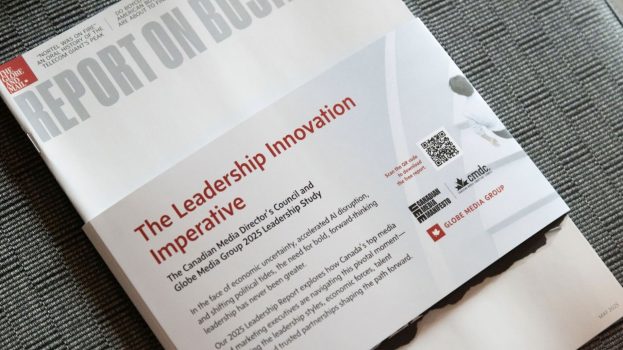Tim Penner arrived at Procter & Gamble in 1978, a fresh-faced Wilfrid Laurier grad full of questions. “They told me on day one that I would be working on Downy fabric softener. I didn’t know what it was or why anyone used it,” he recalls.
“Then they handed me a thick rule book on how to orchestrate a sales promotion,” he says. “It was filled with P&G acronyms, so I understood very little of it, but I read that thing cover to cover. I went home exhausted, despite having accomplished nothing, but still eager to make a personal difference on this business any way I could.”
Three decades later, as he retires from his position as president, he’s accomplished this goal, having made a considerable impact on all aspects of the business, here and abroad. Penner’s early work in laundry and then health care marketing ultimately led to a position as GM of the health care business in 1991. In 1993, he relocated with his family to become VP of the health and beauty business in the U.K. and Ireland, and moved again in 1996 to become VP of the North American tissue/towel business, based out of Cincinnati, Ohio.
In 1999, he returned to Canada as president, and since then, the company’s sales have nearly tripled – a feat that he says is his proudest accomplishment.
Strategy sat down with Penner at the end of his term to discuss what he’ll miss, how the company has changed and what legacy he’s left for successor Thom Lachman, P&G’s former VP of male grooming for North America.
Describe a typical week as president of Canada’s largest marketing organization. How do you divide your time?
Half my time is spent trying to fight for a plan that can win in Canada [both within the Canadian and global organization]. Sometimes the Canadian team has decided what it will actually take to win here, but the country that produces it – the group that supplies the communication plans – is not providing it to us. Another quarter of my time is spent with Canadian customer issues – the selling side of the business. The remainder is spent trying to keep people motivated, on track, feeling rewarded, feeling valued and all rowing in the same direction.
You’ve spent over 30 years at P&G. Why was it such a good fit?
P&G is totally committed to talent development and individual responsibility. They gave me lots of early responsibility and they kept stretching me with challenging assignments that allowed me to learn and grow. Every one of my bosses invested in my development. This is a company that loves ideas [and] does the right thing.
What’s the key to a long career within an organization?
First, you need to join a company that will win in the marketplace, so that when they grow it will create opportunities for you. Second, you need to consistently deliver great results. This is a very measurable industry and it is very clear who is contributing and who is not. Third, you need to consistently treat absolutely every person you meet with respect.
You relocated twice in your career with P&G. Do you think international experience made you a better marketer?
Moving internationally was the best thing I ever did for my career and for my family. It stretched us all, took us out of our comfort zone, forced us to learn new things, to build new skills, and it brought us together as a family. As a business person, being outside the comfort of your home market teaches you to rely even more heavily on the people around you because they have a better “feel” for the marketplace.
How has P&G changed over the last 30 years?
We’ve become much more efficient and much less formal. We have gotten rid of the big formal meetings and senior management visits. We’ve also worked hard to get rid of the functional and hierarchical barriers that used to get in the way of free-flowing communication.
How else has the corporate culture changed?
We are more reflective now of the population that we serve than we were 12 years ago. I think we’re doing a better job today at having people feel valued for the work that they’re doing and understanding why they need to do it. We’ve implemented a great training program for managers, a local invention, that has been really well received. We want our people to thrive here and so you have to keep trying new things to stimulate the right kind of culture.
How has the CPG industry changed?
When I started in this business it was Canada-centric and TV-centric. We debated for hours over word tweaks to the copy strategy document, and we might produce one or two pieces of creative in a year on any given brand. Now most of our communication plans are global campaigns. The task is to choose from a global menu of ideas and then integrate the communication plans locally between a communications planning agency, a digital agency, a PR agency, an in-store agency and a trial/promotion agency. It takes much more work today to influence the consumer across all the touchpoints that influence his or her life.
When P&G was named our Brand of the Year in 2008, you told strategy, “We need to make all of our communication more interesting if we want to break through.” Are you there yet?
I think P&G’s 32 Cannes Lions this year indicate that we are making progress, but we must do more. Many of the categories in which we do business are not inherently interesting, so we have a tough task to help make our brands interesting to consumers. We need to make it worth the time to listen to our message, in every medium.
How would you describe the role that digital plays?
Digital is by far the fastest growing portion of our marketing communications budget. At first we jumped into digital communication as an experiment, because that’s where viewership was heading. We learned a lot about how to use the medium and we are improving our ROI. Digital has become the largest spending pool for some of our brands.
What results have you seen from content plays like P&G’s Rouge magazine and Tampax’s Beinggirl.ca?
We are always looking for ways to cut through the clutter, to make our brand message part of the storyline rather than a blatant commercial interruption in the reading or viewing experience. With Rouge magazine we can tailor the articles to focus on content that complements our new product launches and brand messages. The result is a highly integrated message. Readers seem to like it; our loyalty and click-through rates are very strong.
With Beinggirl.ca there was a need for a discreet way for young girls to get answers to their fem care questions. We created a website and consumers flocked to it. We’ve done the same thing in TV when we sponsored shows and integrated our ad message into the content. The intent is to make our message even more relevant. When we can do this at a reasonable cost, it’s worth it.
Last year your big focus was “game-changing initiatives” and “transforming categories.” What worked and what’s next?
Our big product innovations have generally been very successful, but Crest 3D White and Gillette ProGlide really exceeded our expectations. We will continue to focus on category-transforming news in the future. More and more we are learning that we need to “go big or stay home” with our product news. The cost to the manufacturer and the cost to the retailer of refitting a shelf are enormous. We need to bundle innovation to make it worthwhile to truly transform the retail shopping experience.
Why has innovation been so pivotal at P&G and how have you fostered it?
I think leaders foster a direction by showing their interest and enthusiasm. I’m genuinely interested in innovative new ways of doing business. If you run the same plan as last year your business will decline, because competitors will throw you a curve ball you didn’t anticipate.
What are you most proud of?
I’m proud of the total growth we achieved. Twelve years ago P&G was one of many mid-to-large consumer goods manufacturers operating in Canada. Today we are the largest – larger than our five closest competitors combined. Some growth was achieved through global acquisitions and some through organic growth. The team integrated the acquisitions quickly and smoothly, and we found innovative ideas to grow existing businesses.
What are your plans moving forward?
My immediate challenge is that I’ve agreed to lead a fundraising campaign for the Toronto YMCA. Today there is a Y facility within easy access to about 65% of the Toronto population. The goal is to build additional facilities so that 95% of the population can enjoy a Y centre in their neighborhood. The Y has never been a big fundraiser, with total donations of roughly $3 million per year. We want to raise $400 million in the next 10 years to achieve our dreams.
You’ve lent your skills to a number of charitable organizations. Why has this been important?
I’m very lucky, I was relatively successful quite early on. As you do well, you have a responsibility to do good.
Why did you decide to retire now?
I actually believed all those ads for Freedom 55.
What will you miss the most?
I’ll miss the people and the enthusiasm for new ideas. This is a remarkable place.
What will you miss the least?
I will not miss flying Comair to Cincinnati.
Any other last words you’d like to share?
I’ve known Thom Lachman for over 10 years and I am delighted to be handing the reins to such an outstanding individual. With the strength of the team and Thom’s leadership, I know P&G will continue to thrive in Canada.
***
Questions from the peanut gallery
We asked some of Penner’s colleagues and golf buddies to contribute a few questions for this interview. Here’s what they wanted to know:
Brian Fetherstonhaugh, OgilvyOne: How do you create a culture that has both business discipline and fun baked in?
Tim Penner: That is the quintessential challenge for senior leaders. I think you do it by truly engaging the fun, creative spirit of everyone. Fun isn’t top down. It has to come from every level.
Aidan Tracey, Mosaic: What hasn’t changed over the past 30 years, in terms of delivering great marketing?
TP: It’s still about communicating. You have
to interest people, you have to reward them. The medium has changed, but that hasn’t.
Jim McKenzie, Maxim Partners: You are retiring at a relatively young age. Are you just going to do board and charity work, or do you have another mountain to climb?
TP: The only way to know that is to not climb any mountains for a while and see how that feels. My plan is to not climb anything for the rest of the calendar year.
BF: Does your retirement give you an unfair advantage in next year’s boys’ golf tournament, and how will you compensate your competitors ?
TP: (He laughs.) Just to give you the backstory, this is a trip that eight guys at P&G started going on 32 years ago and one that most guys have never missed. It predates all of our marriages – it was a prenup for all of us. To answer the question, I hope that it gives me an enormous advantage and I will exploit it as much as possible.
JM: Everyone has enormous respect for you. What is it about your business approach that engenders this level of admiration?
TP: I fake humility well.
BF: Is it true that you are the lost Osmond brother?
TP: (He laughs again.) You should see my yearbook photo.
***
Tales from the trenches
Tim is an extraordinary combination of charisma and content. He is the kind of leader who people want to follow.
One thing people should know about Tim is that he’s actually pretty cheap. On one of our annual boys’ golf trips – 32 years and still counting – I was rooming with Tim. After a very long night of playing Liar’s Dice and maybe sinking a few beers, I woke up in the morning and discovered that I had slept in Tim’s suitcase. The most shocking thing wasn’t waking up inside the luggage. It was that Tim didn’t charge me a night’s rent. The one thing you never do with Tim Penner is bug him for money.
–Brian Fetherstonhaugh, chairman and CEO, OgilvyOne Worldwide
Tim is one of the true gentlemen in the business. He always returns your calls, always tells it like it is and always does what he says.
Tim is also one of those guys who you can’t say no to. One day Tim called to ask a favour. Could I help him out on a little project? It would be fun, just a little United Way thing. I asked what it was and he said I could find out more at breakfast. So off I trundled only to find out I would be in his asking-people-for-money cabinet, a wonderful and important cause which he took very seriously. By the time he was finished with me, I was signed up for a 10-year term. No wonder he was so successful!
–John Clinton, CEO, Edelman Canada
Tim is one of the best, if not the best, client I ever worked with. He is very smart, intuitive, fair, very personable and has a killer sense of humour. But Tim’s real gift is his integrity and his ability to inspire everyone to be their very best. You just would never want to disappoint Tim or let him down.
From a personal standpoint, I feel very fortunate that our professional relationship evolved into a long-term friendship. However, when it comes down to a golf bet, we would give each other no quarter.
–Jim McKenzie, partner, Maxim Partners
Tim has brought a fresh perspective to our YMCA board.
One of the things that really impresses me and my colleagues is Tim’s great ability to grasp complex challenges and put them into clear and simple terms
that are both understandable and action oriented.
Most recently, Tim summarized one of our strategies by coining the phrase “this is about spreading acorns and planting oak trees,” making a written plan come to life with such a powerful metaphor.
In a nutshell, I would describe Tim as a successful business leader and a humble humanist.
–Medhat Mahdy, president and CEO, YMCA
When I reflect on 20 years of either working for Tim or being on the other side of the table as an agency partner, it’s his leadership style that stands out. Tim’s style of calmly asking for the fact-based rationale for a decision and then rallying people in a direction was powerful. That even keel allowed him to be a respected voice both internally and externally in the marketing community – which is often needed.
One of the only times I remember that calm style
getting ruffled was when an agency supplier sent
over about 30 pounds of steaks to all the brand team people in our division at Christmas [despite a strict corporate policy against accepting gifts]. Needless
to say that particular agency president got a solid scolding and ended up receiving a lot of red meat
shipped back.
–Aidan Tracey, CEO, Mosaic Sales Solutions
Tim has been an incredible supporter of the industry over his career. He always took his role on the Food and Consumer Products of Canada (FCPC) board seriously, always adding value and always speaking his mind. He would never shy away from the tough decisions, would always say what he thought even if it wasn’t the most popular opinion in the room and was respected by all of his peers for just that. When Tim spoke, everyone knew it was well worth listening. Tim is a natural leader and one our industry will really miss.
–Nancy Croitoru, president and CEO, FCPC
























